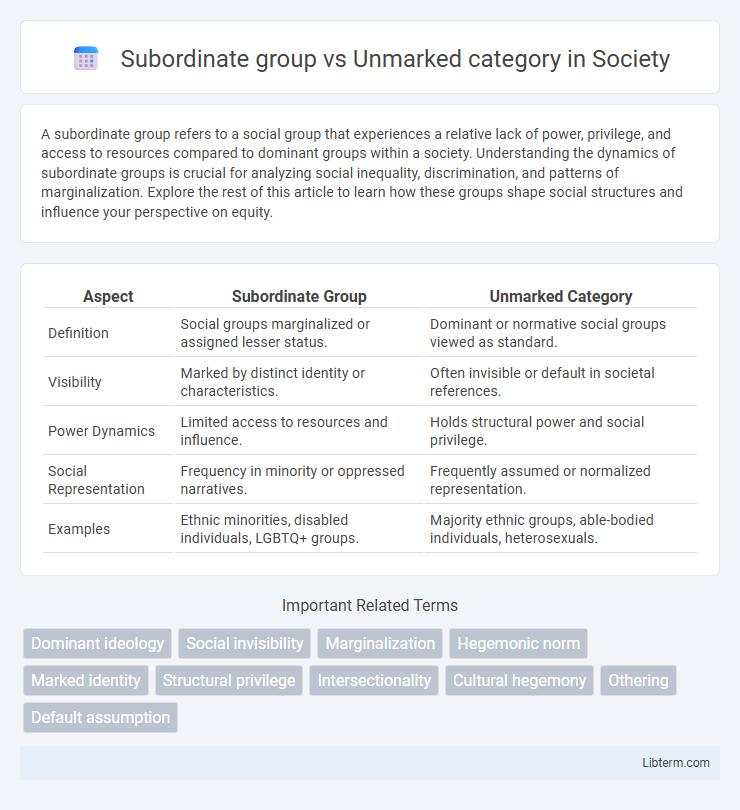A subordinate group refers to a social group that experiences a relative lack of power, privilege, and access to resources compared to dominant groups within a society. Understanding the dynamics of subordinate groups is crucial for analyzing social inequality, discrimination, and patterns of marginalization. Explore the rest of this article to learn how these groups shape social structures and influence your perspective on equity.
Table of Comparison
| Aspect | Subordinate Group | Unmarked Category |
|---|---|---|
| Definition | Social groups marginalized or assigned lesser status. | Dominant or normative social groups viewed as standard. |
| Visibility | Marked by distinct identity or characteristics. | Often invisible or default in societal references. |
| Power Dynamics | Limited access to resources and influence. | Holds structural power and social privilege. |
| Social Representation | Frequency in minority or oppressed narratives. | Frequently assumed or normalized representation. |
| Examples | Ethnic minorities, disabled individuals, LGBTQ+ groups. | Majority ethnic groups, able-bodied individuals, heterosexuals. |
Understanding Subordinate Groups: Definitions and Characteristics
Subordinate groups refer to social categories that experience systemic disadvantages in power, status, and opportunities compared to dominant or unmarked categories. These groups are often defined by characteristics such as race, ethnicity, gender, or class, and face structural barriers resulting in unequal treatment or marginalization. Understanding subordinate groups involves analyzing patterns of discrimination, social exclusion, and cultural stereotyping that reinforce their subordinate status in society.
What is the Unmarked Category? Key Concepts and Examples
The unmarked category refers to the default or neutral state in a classification system, often characterized by the absence of specific markers or qualifiers that distinguish marked categories. Key concepts include its role as the baseline against which subordinate groups--those defined by distinct, marked features--are compared. For example, in gender studies, the unmarked category "male" contrasts with the subordinate group "female," which carries additional social and linguistic markers.
Historical Contexts: Origins of Subordinate Groups and Unmarked Categories
Subordinate groups historically emerge from systems of power imbalance, colonization, and social stratification, often defined by race, ethnicity, gender, or class to justify unequal treatment. Unmarked categories represent dominant social groups normalized within cultural and linguistic contexts, maintaining invisibility and unchallenged privilege. The origins of subordinate groups trace back to social constructions shaped through legislation, social norms, and institutional practices, while unmarked categories persist through cultural hegemony and linguistic practices that render them the default reference point.
Power Dynamics: How Unmarked Status Maintains Dominance
The unmarked category, often representing the dominant group, maintains power by establishing itself as the normative standard against which subordinate groups are compared, thereby reinforcing social hierarchies subtly through language and cultural norms. Subordinate groups are marked by distinct labels or characteristics, which highlight their "otherness" and justify unequal treatment or marginalization. This dynamic perpetuates systemic dominance by normalizing the unmarked group's traits as universal, while subordinating alternative identities as deviations.
Visibility and Invisibility: Social Implications of Markedness
Subordinate groups often face heightened visibility due to markedness, which highlights their differences and can lead to social marginalization. In contrast, unmarked categories typically embody the normative standard, rendering them invisible and unexamined within societal structures. This dynamic reinforces power imbalances by making subordinate identities more susceptible to stereotyping while maintaining the dominance of unmarked groups.
Language and Labeling: Influence on Subordination and Unmarking
Subordinate groups in language are often labeled with marked terms that emphasize difference or inferiority, reinforcing social hierarchy and marginalization. Unmarked categories function as the default or norm, remaining unnamed and thus gaining a position of dominance through linguistic invisibility. This labeling dynamic influences cognition and social perception by embedding power structures into everyday communication.
Intersectionality: Overlapping Identities in Subordinate and Unmarked Groups
Subordinate groups often experience compounded marginalization due to overlapping identities such as race, gender, and class, which intersect and intensify social disadvantages. Unmarked categories, typically representing dominant social groups, remain invisible, reinforcing their normative status and masking the intersections of privilege that silence marginalized voices. Analyzing intersectionality reveals how subordinate identities face systemic inequalities while unmarked groups maintain structural power through unacknowledged intersections of identity.
Media Representation: Subordinate Groups versus Unmarked Categories
Media representation often positions subordinate groups as peripheral or stereotypical, limiting their visibility and reinforcing social hierarchies. Unmarked categories, typically reflecting the dominant cultural norm, receive normalized and widespread portrayal, shaping audience perceptions of standard identities. This disparity in media framing influences societal attitudes, perpetuating marginalization of subordinate groups and maintaining the dominance of unmarked categories.
Consequences of Othering: Social, Economic, and Psychological Effects
Othering through the distinction between subordinate group and unmarked category fosters social exclusion, reinforcing systemic inequalities that limit access to resources and opportunities for the marginalized. Economic disparities arise as subordinate groups often face restricted employment, wage gaps, and reduced upward mobility due to discriminatory practices embedded in institutions. Psychologically, individuals in subordinate groups experience heightened stress, identity conflicts, and diminished self-esteem stemming from persistent marginalization and stereotypes perpetuated by the dominant, unmarked category.
Toward Equity: Challenging the Unmarked Category and Empowering Subordinate Groups
Challenging the unmarked category requires recognizing its role in perpetuating systemic biases that marginalize subordinate groups. Empowering subordinate groups involves amplifying their voices and experiences to disrupt normative assumptions embedded in dominant social categories. Toward equity, this approach fosters inclusivity by redefining societal norms to validate diversity beyond the unmarked, privileged identity.
Subordinate group Infographic

 libterm.com
libterm.com